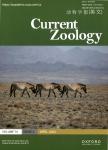Frequency-dependent flight activity in the colour polymorphic wood tiger moth
彩色多型木材虎蛾的频率相关飞行活动作者机构:University of Jyvaskyla Centre of Excellence in Biological Interactions Department of Biology and Environmental Sciences POBox 35 FI 40001 Finland
出 版 物:《Current Zoology》 (动物学报(英文版))
年 卷 期:2015年第61卷第4期
页 面:765-772页
核心收录:
学科分类:0710[理学-生物学] 08[工学] 09[农学] 0904[农学-植物保护] 090401[农学-植物病理学] 090402[农学-农业昆虫与害虫防治] 0825[工学-航空宇航科学与技术]
基 金:funded by the Centre of Excellence in Biological Interactions funded by the Centre of Excellence in Biological Interactions
主 题:Frequency-dependent selection Flight Colour polymorphism Sexual selection Aposematism
摘 要:Predators efficiently learn to avoid one type of warning signal rather than several, making colour polymorphisms un- expected. Aposematic wood tiger moth males Parasemia plantaginis have either white or yellow hindwing coloration across Eu- rope. Previous studies indicate that yellow males are better defended from predators, while white males have a positively frequency-dependent mating advantage. However, the potential frequency-dependent behavioural differences in flight between the morphs, as well as the role of male-male interactions in inducing flying activity, have not been previously considered. We ran an outdoor cage experiment where proportions of both male morphs were manipulated to test whether flying activity was frequency- dependent and differed between morphs. The white morph was significantly more active than the yellow one across all treatments, and sustained activity for longer. Overall activity for both morphs was considerably lower in the yellow-biased environment, suggesting that higher proportions of yellow males in a population may lead to overall reduced flying activity. The activity of the yellow morph also followed a steeper, narrower curve than that of the white morph during peak female calling activity. We sug- gest that white males, with their presumably less costly defences, have more resources to invest in flight for predator escape and finding mates. Yellow males, which are better protected but less sexually selected, may instead compensate their lower flight ac- tivity by 'flying smart' during the peak female-calling periods. Thus, both morphs may be able to behaviourally balance the trade-off between warning signal selection and sexual selection. Our results emphasize the greater need to investigate animal behaviour and colour polymorphisms in natural or semi-natural environments [Current Zoology 61 (4): 765-772, 2015].



